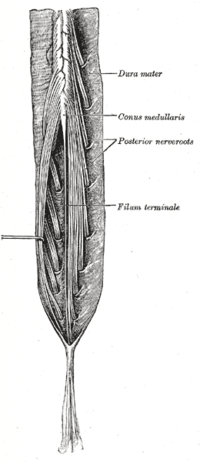| Cauda equina | |
|---|---|
| Cauda equina and filum terminale seen from behind. | |
| Human caudal spinal chord anterior view | |
The cauda equina is a structure within the lower end of the spinal column of most vertebrates, that consists of nerve roots and rootlets from above. The space in which the cerebrospinal fluid is present is actually an extension of the subarachnoid space.
In humans, because the spinal cord stops growing in infancy while the bones of the spine continue growing, the spinal cord in adults ends at about the level of the vertebra L1/L2 , and at birth at L3. However there is some variation in adults and the cord may end anywhere between vertebrae T12 to L3. Individual spinal nerve roots arise from the spinal cord as they do closer to the head, but as the differential growth occurs the top end of the nerve stays attached to the spinal cord and the lower end of the nerve exits the spinal column at its proper level, this results in a "bundle"-like structure of nerve fibres that extends caudally from the end of the spinal cord, gradually declining in number further down as individual pairs leave the spinal column. At the base of the Cauda Equina, there are approximately 10 fibre pairs, 3-5 lumbar, 5 sacral, and the single coccygeal nerve.
Etymology
All these roots and rootlets down the vertebral column give the appearance of a horse's tail, which is the meaning of the Latin name cauda equina.
Clinical relevance
Cauda equina is the part of the spinal cord where a lumbar puncture is performed in order to obtain a sample of cerebrospinal fluid (CSF) for diagnostic purposes.













No comments:
Post a Comment